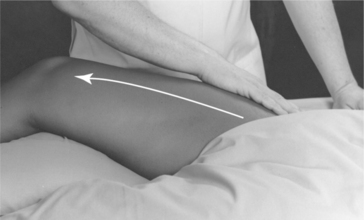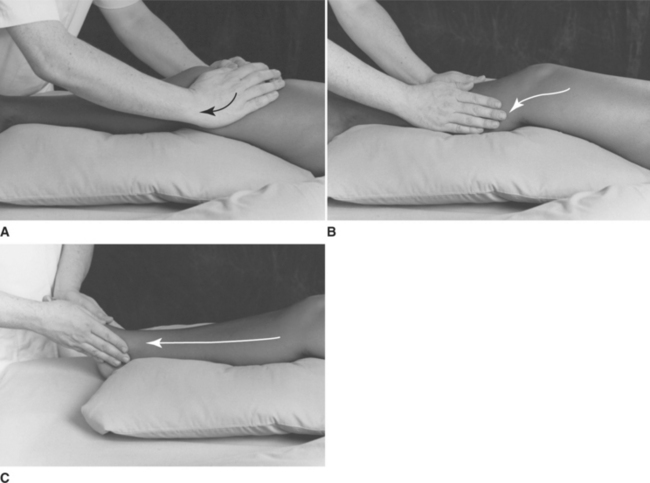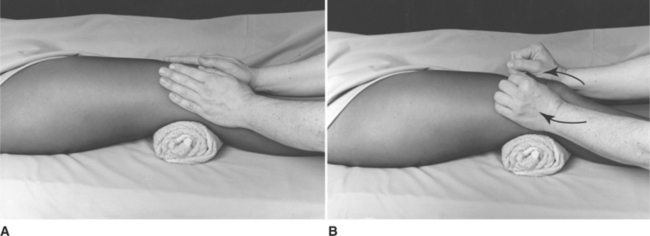Chapter 7 General Massage Sequences
Part Two of this text concerns the practice of the various soft tissue manipulations (massage strokes) described previously in Chapter 4. These techniques can be combined into a wide variety of massage sequences. Such a sequence is simply a collection of individual techniques put together with the intention of achieving a specific effect or series of effects. Of the many massage sequences that are possible, the selection of techniques should, to a large extent, be determined by the specific treatment goals. The massage sequences described in this text are by no means the only ones that could be practiced. Indeed, the possible sequences are practically endless. In this context, massage applied to the entire body is usually called general massage, which was defined in Chapter 3 as follows:
In contrast, massage applied to an individual body part is termed local massage, and massage given to a specific site, such as a ligament or tendon, is called focal massage. Local massage sequences are described in Chapter 8, and some examples of focal massage are discussed in Chapter 9.
Massage is never intended to be a substitute for therapeutic exercise in restoring a patient to full function. Because massage can improve the circulation of blood and lymph, mobilize soft tissues of all types, and promote healing, relaxation, and pain relief, it has many of the effects of exercise, with one important difference. Therapeutic exercise involves muscle contraction, usually with accompanying joint and soft tissue movement. In contrast, therapeutic massage is entirely passive in nature. In fact, relaxation of the patient is a necessary part of the treatment. This in no way implies that massage is inferior to exercise. It is simply different but complementary in every respect. In fact, it is appropriate to view soft tissue manipulation as an excellent way of preparing the tissues for active exercise. In this way it can be thought of as a passive warm-up. When followed by passive and active stretching, it can be an effective and indeed essential component of the routine of preparation for exercise. This is one of the major ways in which massage techniques can be used in sports (see Chapter 13 for more details).
A SEQUENCE AND TECHNIQUE FOR GENERAL MASSAGE
A good general massage may produce fatigue in the patient. A feeling of mild lassitude and the desire to rest immediately after general massage are signs of a successful treatment, and for this reason the patient should rest for 60 to 90 minutes after treatment if possible. Significant fatigue should be avoided, and if the patient is not refreshed after a period of rest, the duration of the treatment has been too long or the massage technique too vigorous. As a general guide, about 45 minutes to 1 hour is adequate for most general massage treatments. In the general massage sequence described here, a recommended number of repetitions is given for each stroke so that the treatment can be completed within this time frame.
To accomplish the relaxation and sedation usually desired in general massage, the change from one type of movement to another must be smooth and uninterrupted, and a definite rhythm should be sustained through all movements. Certain adaptations of the Swedish remedial massage system seem to be well suited for this purpose. These movements are performed on an entire segment of each extremity without giving special attention to a particular muscle or muscle group. A type of massage sequence that follows specific muscle groups and muscles is more effective in the treatment of local injury or disease (see Chapters 8 and 9).
TECHNIQUES FOR A GENERAL MASSAGE SEQUENCE
Tables 7-1 to 7-5 describe general massage sequences for the lower limbs, upper limbs, anterior trunk, posterior trunk, and the head/neck area.
Table 7-1 General Massage Sequence for Lower Limbs
| LIMB | FIGURE | REPETITIONS |
|---|---|---|
| Right Thigh | ||
| Superficial stroking to the thigh | 7–1 | 4 |
| Palmar kneading to the quadriceps muscle | 7–2 | 3 |
| Palmar kneading to the posterior thigh | 7–3 | 3 |
| Palmar kneading to the medial and lateral thigh muscles | 7–4 | 3 |
| Deep stroking to the thigh | — | 3 |
| Right Leg and Knee | ||
| Superficial stroking to the leg | 7–5 | 3 |
| Thumb pad kneading to the anterior tibial muscles | 7–6 | 2 |
| Kneading to the calf muscles | 7–7 | 3 |
| Palmar kneading to the muscles of the leg | — | 3 |
| Stroking around the patella | 7–8 | 4 |
| Deep stroking to the popliteal space | — | 4 |
| Deep stroking with both hands to the entire leg | — | 3 |
| Right Foot | ||
| Superficial stroking to the dorsum of the foot | 7–9 | 2 |
| Thumb pad kneading to the dorsum of the foot | 7–10 | 2 |
| Deep thumb pad stroking to the plantar aspect of the foot | 7–11 | 2 |
| Deep palmar stroking to the plantar aspect of the foot | 7–12 | 4 |
| Deep digital stroking around the malleoli | 7–13 | 4 |
| Digital stroking to the Achilles tendon | 7–14 | 4 |
| Deep stroking to the leg and thigh | — | 3 |
| Superficial stroking to the right thigh, leg, and foot | — | 4 |
| Left Thigh, Leg, and Foot | ||
| All of the previous strokes are repeated on the left lower limb | — | |
Table 7-2 General Massage Sequence for Upper Limbs
| LIMB | FIGURE | REPETITIONS |
|---|---|---|
| Left Arm, Forearm, and Hand | ||
| Superficial stroking to the upper limb | 7–15 | 4 |
| Deep palmar stroking to the deltoid muscle | 7–16 | 5 |
| Thumb pad kneading to the upper limb | 7–17 | 2 |
| Palmar kneading to the arm and forearm | 7–18 | 3 |
| Alternate palmar kneading to the upper limb | 7–19 | 3 |
| Thumb pad kneading to the dorsum of the hand | 7–20 | 2 |
| Thumb stroking to the palmar surface of the metacarpophalangeal joints | 7–21 | 4 |
| Thumb stroking to the thenar and hypothenar eminences | 7–22 | 4 |
| Thumb pad kneading to the thumb and fingers | 7–23 | 3 |
| Deep stroking to the upper limb | — | 3 |
| Superficial stroking to the upper limb | — | 4 |
| Right Arm, Forearm, and Hand | ||
| All of the previous strokes are repeated to the right upper limb | — | |
Table 7-3 General Massage Sequence for the Anterior Trunk
| BODY AREA | FIGURE | REPETITIONS |
|---|---|---|
| Upper Chest, Neck, and Shoulders | ||
| Superficial stroking to the upper chest | 7–24 | 4 |
| Deep stroking to the shoulders and neck | 7–25 | 4 |
| Digital kneading from the sternum to the shoulder | 7–26 | 3 |
| Alternate deep stroking from the shoulder to the sternum | — | 4 |
| Digital stroking to the neck | 7–27 | 4 |
| Deep stroking to the areas of the jugular veins | 7–28 | 4 |
| Deep stroking to the neck | — | 4 |
| Abdomen | ||
| Superficial stroking to the abdomen | — | 4 |
| Deep stroking to the lower abdominal muscles | 7–29 | 4 |
| Deep stroking to the upper abdominal muscles | 7–30 | 4 |
| Palmar kneading over the colon | 7–31 | 3 |
| Deep stroking over the colon | 7–32 | 6 |
| Alternate squeeze kneading over the entire abdomen | 7–33 | 4 |
| Deep stroking to the lower abdomen | — | 4 |
Table 7-4 General Massage Sequence for the Posterior Trunk and Pelvis
| BODY AREA | FIGURE | REPETITIONS |
|---|---|---|
| Back and Hips | ||
| Superficial stroking to the back | 7–34 | 4 |
| Deep palmar stroking to the back | 7–35 | 3 |
| Finger pad kneading over the upper fibers of the trapezius | 7–36 | 3 |
| Deep stroking over the upper fibers of the trapezius | 7–37 | 4 |
| Reinforced palmar kneading over the scapular region | 7–38 | 3 |
| Palmar kneading to the thoracic and lumbar regions | 7–39 | 4 |
| Palmar stroking to the lumbar region | 7–40 | 4 |
| Thumb pad kneading to the sacrum | 7–41 | 4 |
| Alternate palmar kneading to the gluteal muscles | 7–42 | 2 |
| Reinforced kneading to the gluteal muscles | 7–43 | 2 |
| Alternate palmar kneading over the entire back | — | 4 |
| Digital kneading to the erector spinae muscles | — | 1 |
| Deep stroking to the erector spinae muscles | 7–44 | 4 |
| Superficial stroking to the entire back | — | 4 |
| Posterior Neck Region | ||
| Superficial and deep stroking to the upper fibers of the trapezius muscle | — | 8 |
| Finger pad kneading to the upper fibers of the trapezius muscle | — | 3 |
| Deep stroking over the upper fibers of the trapezius muscle | — | 6 |
Table 7-5 General Massage Sequence for the Head and Neck
| BODY AREA | FIGURE | REPETITIONS |
|---|---|---|
| Face and Anterior Neck | ||
| Superficial stroking to the face | 7–45 | 2 |
| Thumb pad kneading to the forehead | 7–46 | 2 |
| Deep stroking to the forehead | 7–47 | 3 |
| Thumb pad kneading to the nose | 7–48 | 3 |
| Deep stroking to the supraorbital ridge | 7–49 | 4 |
| Deep stroking to the infraorbital ridge | 7–50 | 4 |
| Finger pad kneading from the temple to the cervical spine | 7–51 | 2 |
| Finger pad kneading from the temples to the shoulders | 7–52 | 2 |
| Deep stroking over the area of the jugular veins | — | 4 |
| Palmar kneading to the cheeks | 7–53 | 2 |
| Thumb pad kneading to the chin and lower jaw | 7–54 | 3 |
| Deep stroking to the chin and lower jaw | 7–55 | 3 |
| Deep stroking over the jugular veins | — | 4 |
| Superficial stroking of the face | — | 2 |
| Scalp | ||
| Finger pad kneading over the scalp | — | 2 |
SPECIFIC TECHNIQUES FOR A GENERAL MASSAGE SEQUENCE
Lower Limb
Right Thigh
The therapist stands at the side of the table on the patient’s right side.
Superficial Stroking to the Thigh
Both hands reach around the thigh, covering it as much as possible, and stroke from the anterior superior iliac spine (ASIS) of the ilium to the knee. The stroke may be performed with the hands working alternately or simultaneously (Figure 7-1). The technique is repeated four times.
Palmar Kneading to the Quadriceps Muscle
Palmar kneading is a modified squeeze kneading technique that begins with the ulnar border of the right hand placed below the patella and the thumb on its lateral border. The fingers are placed on the medial border of the patella. The left hand picks up the distal portion of the muscle above the patella (Figure 7-2, A). The right hand strokes over the patella toward the left hand as the ulnar border maintains firm contact during the upward pressure. The muscle is grasped between the thumb and the fingers using a lumbrical action to draw the tissues into the palms of the hands. The palmar surface of the fingers of the left hand pulls the muscles laterally as the surface of the abducted right thumb and palm simultaneously push the tissues medially (Figure 7-2, B). Then the surface of the palm and abducted thumb of the left hand push the muscles medially as the palmar surface of the fingers of the right hand pulls the tissues laterally (Figure 7-2, C). This push-pull movement is carried along the muscle, progressing from the distal part of the quadriceps to the proximal part. Movement is accomplished with gliding of the hands on the pull stroke of the kneading movement. This is not a pinching movement. The thumb and fingers of each hand sustain their relationship to each other during the entire movement. The push and pull are accomplished chiefly by flexion and extension of the arms at the shoulders and elbows as the movement progresses along the thigh. As the origin of the muscle is approached, the left hand is removed, and the right hand gently squeezes out at the origin of the muscle (Figure 7-2, D) and returns to the lower border of the patella with a superficial stroke. These movements are repeated three times.
Palmar Kneading to the Posterior Thigh
The hip and knee are flexed a little and the thigh rotated slightly externally. Both hands reach across the medial surface of the thigh, grasping the flexors at the knee (Figure 7-3, A), in a manner similar to the movement that was performed on the quadriceps muscle, except that the hands are held more transversely to the muscles as the hands progress along the muscle (Figure 7-3, B).
The movement is terminated a few inches below the hip joint. The left hand is removed; it crosses over the right hand to grasp the muscles above the knee (see Figure 7-3, C), and the right hand returns along the medial surface of the thigh with a superficial stroke. The movement is repeated three times.
Palmar Kneading to the Medial and Lateral Thigh Muscles
The hip may be slightly flexed and laterally rotated for this stroke, or it may be performed with the limb straight. Both hands grasp around the upper portion of the thigh (Figure 7-4, A); the hands perform the basic circular kneading technique, alternately rolling the muscles between the palms with firm pressure upward and relaxation while moving down the thigh toward the knee (Figure 7-4, B). Both hands return to the starting position with a deep stroke. The stroke is repeated three times.
Right Leg and Knee
Superficial Stroking to the Leg
Both hands stroke from the knee to the ankle in the standard method for this technique, covering the entire surface of the leg (Figure 7-5). This movement is also repeated three times.
Thumb Pad Kneading to the Anterior Tibial Muscles
The thumb pad (distal phalanx) of each hand is placed in firm contact at the origin of the anterior tibial muscles; the remainder of the hand rests lightly on the surface of the leg (Figure 7-6, A). The thumbs move alternately in the basic manner for kneading, applying pressure in a circular manner. The hands glide to the more distal adjacent area as each circle is made. The movement progresses in this manner (Figure 7-6, B) to the ankle joint (Figure 7-6, C). The hands return to the starting position as the thumbs give deep stroking and the rest of the hand maintains light contact. The movements are repeated twice.
Kneading to the Calf Muscles
Kneading to the calf muscles is a modified squeeze kneading technique in which the right hand supports the slightly flexed knee joint at the medial border. The left hand grasps the lateral part of the muscle group just distal to the knee, and the muscles are pulled toward the lateral border of the leg with the palmar surface of the fingers exerting pressure (Figure 7-7, A). The palmar surface of the abducted thumb and thenar eminence push the muscles upward and toward the medial border of the leg (Figure 7-7, B). The fingers then glide distally, and these movements are repeated until the hand reaches the ankle (Figure 7-7, C). The hand returns to the knee with a deep stroke over the muscles. These movements are repeated three times.
Palmar Kneading to the Muscles of the Leg
The basic circular kneading stroke is performed as both hands grasp around the muscles at the knee and alternately roll the muscles between the palms with firm pressure upward, working toward the ankle. The hands are returned to the knee with a deep stroke over the muscles. (This is the same technique used in palmar kneading of the thigh; see Figure 7-4.) These movements are repeated three times.
Stroking around the Patella
The heels of both hands are placed at the lower border of the patella; the palmar surfaces of the distal phalanges of the fingers are in contact with the skin above the superior border of the patella (Figure 7-8, A). The thenar eminences of both hands stroke firmly around the patella in a circular movement by allowing the fingers to flex while the tips maintain light contact (Figure 7-8, B). The heels of the hands return to the beginning position with a superficial stroke distally, allowing the thumbs to glide lightly over the patella. These movements are repeated four times.
Deep Stroking with Both Hands to the Entire Leg
Both hands begin the stroke at the ankle in a position similar to that shown in Figure 7-6, C. Both hands then stroke firmly toward the knee, returning to their starting position with a light, superficial stroke. These movements are repeated three times.
















